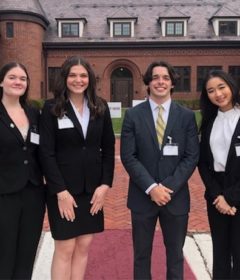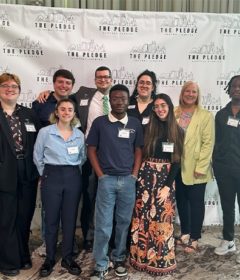“Prints by Women” and Bluemner exhibits open at Hand Art Center
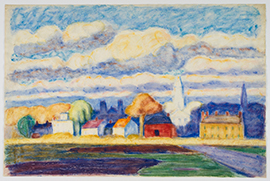
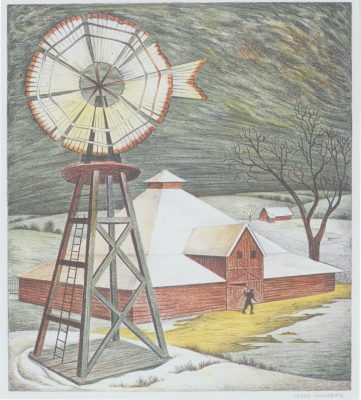
One of the most widely-distributed and popular images of the 1800s, in both Europe and the United States, was the hand-tinted lithograph, “The Sheep Fold,” by French artist Rosa Bonheur.
That work and others are part of the exhibition, “Prints by Women: Selected European and American Works from the Georgia Museum of Art,” which runs Jan. 20 through March 3 at the Hand Art Center on the Stetson University campus.
Another exhibition — “Oscar Bluemner: Becoming a Painter — Works from the Vera Bluemner Kouba Collection,” which features numerous pieces never displayed before — also opens Jan. 20 and runs through May 3 at the Hand center. The Bluemner works are part of a collection of more than 1,000 creations by the German-born American Modernist that were bequeathed to Stetson in 1997.
And the art center also will showcase a “Faculty Spotlight” on Dengke Chen from Jan. 20 through March 3.
Chen’s creative art involves 2D/3D animation, illustration and augmented reality interaction. His animations seek to confront ethical issues such as aggression, racism and animal abuse by showing viewers the relationships between humans, and between humans and nonhumans through an animal’s point of view. He has taught digital art, digital video, 3D modeling and animation, and digital photography.

“Prints by Women”
“Prints by Women” includes 46 woodcuts, lithographs, drypoints, etchings, screenprints and more that date from the 19th through the 21st centuries, each by a different European or American woman artist.
“It’s important for us at the university to represent a variety of different kinds of art,” said Tonya Curran, director of the Hand Art Center. “This is a really incredible print show by women artists. Some of them are very noted artists. Some of them participated in the WPA (Works Progress Administration), which has an important historical component for many reasons.”
As part of President Franklin Roosevelt’s New Deal during the Great Depression (1929-1943), the government created and funded the Federal Art Project of the WPA. Hundreds of artists were hired, and collectively they created more than 100,000 paintings and murals and over 18,000 sculptures. The project employed such artists as Jackson Pollock, Willem de Kooning, Mark Rothko, Thomas Hart Benton and others.
The “Prints by Women” exhibit will serve an educational function, Curran said: “We have a gender studies department on campus and we want to support their teaching, and this exhibition is a great way to do that.”
Also, Curran noted, DeLand once was home to the Florida Museum for Women Artists, which closed in September 2013.
“So that’s a voice we had in our community that we no longer have,” she said. The exhibit will help restore that voice somewhat, although only temporarily.
“This is a great opportunity to showcase work by women,” Curran said.
Along with Bonheur, “Prints by Women” also includes works by Berthe Morisot (French, 1841–1895), Käthe Kollwitz (German, 1867–1945), Ella Fillmore Lillie (American, 1887–1973), Jenne Magafan (American, 1916–1952) and many others.

Bluemner: From Architect to Painter
Oscar Bluemner emigrated from his native Germany to the United States to become an architect. But in the early 1900s, startling new pathways in the art world were seducing Bluemner into painting and away from his work as an architect in New York City.
By the time a crooked business partner soured Bluemner on architecture and led him to abandon that field in 1911, the German native had already explored many of the emerging painting styles.
“Oscar Bluemner: Becoming a Painter — Works from the Vera Bluemner Kouba Collection” explores the early years of the artist who would come to be recognized as a key American Modernist.
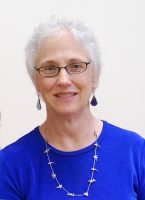
“Artworks Bluemner did when he was a teenager were very beautifully executed but very precise and naturalistic and conventional,” said Roberta Smith Favis, professor emerita of art history at Stetson and curator of the university’s Vera Bluemner Kouba Collection. “In the first 10 years of the 20th century, it’s almost like he’s finding his way through the history of what’s going on in art at the time — quickly working his way, feeling around various styles.”
The exhibit includes 28 watercolor, oil and colored pencil works from 1900 to 1911 – many of them on display for the first time.
“At this point, he’s experimenting but it’s not particularly radical,” Favis said. “He’s kind of assimilating Impressionism and very quickly picking up on ideas from people like Van Gogh and Cezanne and the Pointillists.”
When that shady business partner cheated Bluemner out of credit and payment for a major architectural design project, he became disillusioned with architecture. After winning a lawsuit against the partner in 1911, Bluemner took up painting full time.
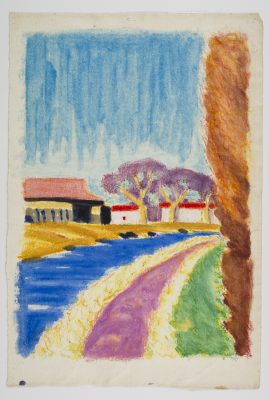
In 1912, he went to Europe for nine months where he exhibited some of his oil paintings, but more importantly he “saw everything that was exciting going on in Modernist painting in Europe,” Favis said. “It was the year when all the hot things happened – Cubism, Futurism, all the German Expressionism.”
Upon returning to New York, Bluemner “made a much more radical break and moved into a more obviously Modernist style,” Favis said. So much so, she added, that he literally “scraped down” his oil works and “completely repainted them.”
Bluemner utilized bold colors and painted what Favis called “the landscape of the common man” – the outer edges of cities and villages “where nature and human progress come together.” Bluemner landed his paintings in the groundbreaking and controversial Armory Show of 1913, the Forum Exhibition of 1916 and the first Whitney Biennial in 1932.
But Bluemner achieved virtually no financial success from his paintings, and his work garnered little attention from the time of his death in 1938 to the beginning of the 21st century.
His daughter, Vera Bluemner Kouba, retired with her husband to DeLand in the 1970s, where the couple enjoyed concerts by Stetson’s School of Music. She bequeathed her collection of her father’s works to Stetson following her death in 1997. The university presented its first Bluemner exhibit in 2004. That show attracted the attention of the Whitney Museum of American Art in New York City, which had already scheduled its own major Bluemner exhibition for 2005. Works from the Stetson collection were loaned to the Whitney for its show.
“Bluemner is now widely acknowledged as a key player in the creation of American artistic Modernism, taking his place alongside better-known colleagues such as Georgia O’Keeffe and John Marin,” Favis said.
“Oscar Bluemner: Becoming a Painter” marks the beginning of the Hand Art Center’s year-long celebration of the sesquicentennial of Bluemner’s birth in 1867. As part of the celebration, the center also will present exhibitions this summer and fall.
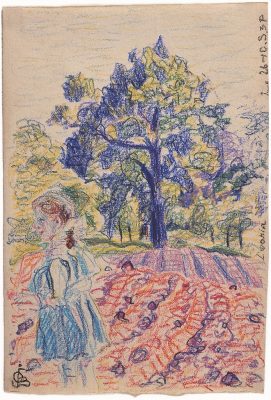
Curran, the Hand Art Center director, said it’s remarkable for Stetson “to have a collection with the scale, the size and the importance of Bluemner in art history. We have over a thousand pieces. The Hirshhorn Museum in Washington has the next largest collection of his work at 80 pieces — that puts it in perspective. For a small university to have this kind of body of work, it’s pretty special.”
— Rick de Yampert
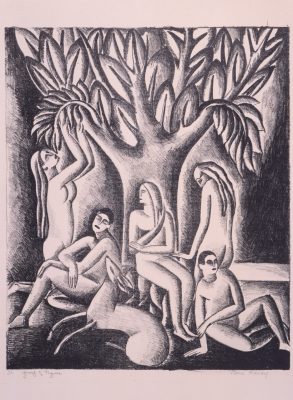
If You Go
“Prints by Women: Selected European and American Works from the Georgia Museum of Art” will run Jan. 20 to March 3 at the Hand Art Center, on the university’s Palm Court/Quad, 139 E. Michigan Ave., DeLand.
“Oscar Bluemner: Becoming a Painter — Works from the Vera Bluemner Kouba Collection” will run Jan. 20 to May 3 at the Hand Art Center.
“Faculty Spotlight: Dengke Chen” will run Jan. 20 through March 3.
An opening reception for the exhibitions will be 6-8 p.m. Jan. 27 at the Hand center.
Regular center hours are 11 a.m.-4 p.m. Monday through Wednesday and Friday; 11 a.m.-6 p.m. Thursday; and noon-4 p.m. Saturday. Closed on university holidays. Admission: Free.
For information: 386-822-7270.
Other upcoming events:
A curator talk by Roberta Smith Favis will be at 7 p.m. March 1 at the duPont-Ball Library, Room 25L, on the Stetson campus.
“Pressing Commitments: 20th Century Women Printmakers and the Demands of Art and Family,” a curator talk by Elizabeth Seaton of the Marianna Kistler Beach Museum of Art at Kansas State University, will be at 7 p.m. Feb. 9 at the duPont-Ball Library, room 25L.


